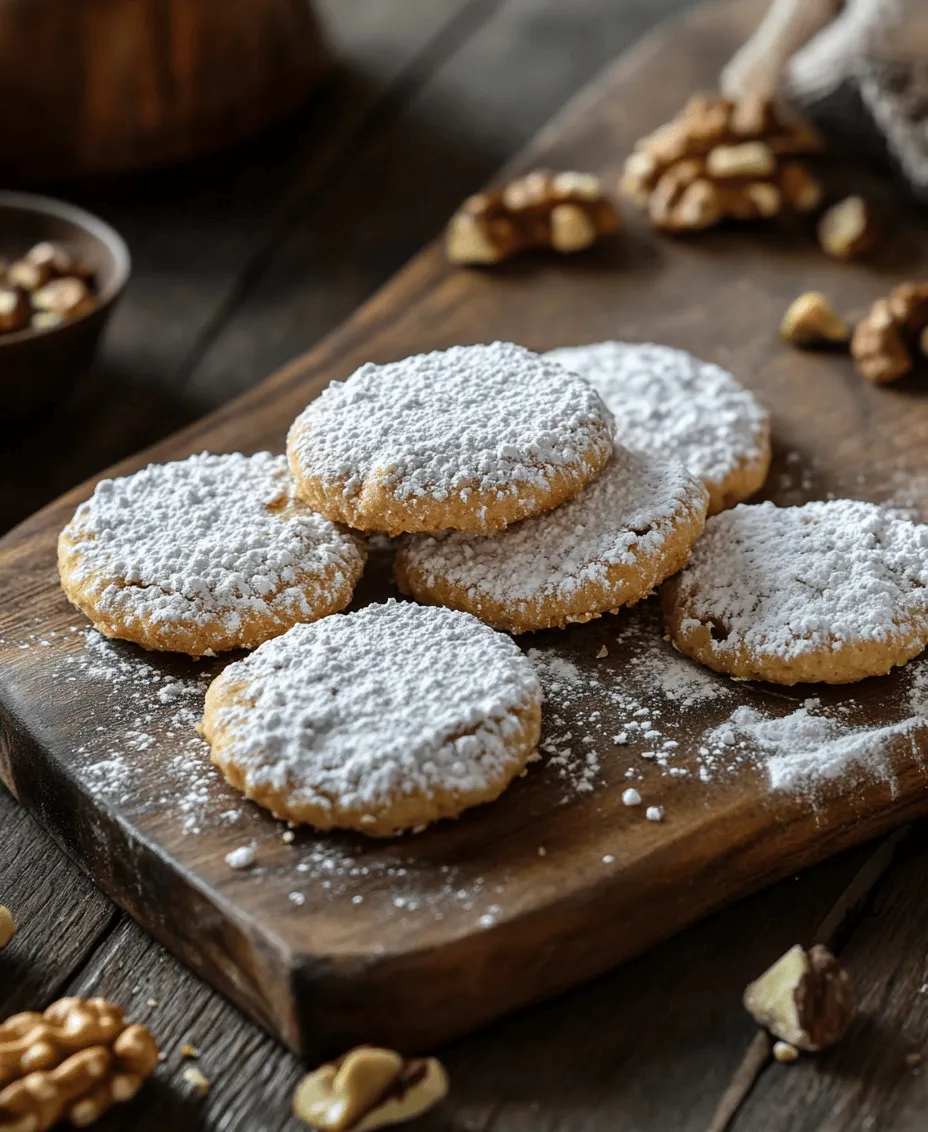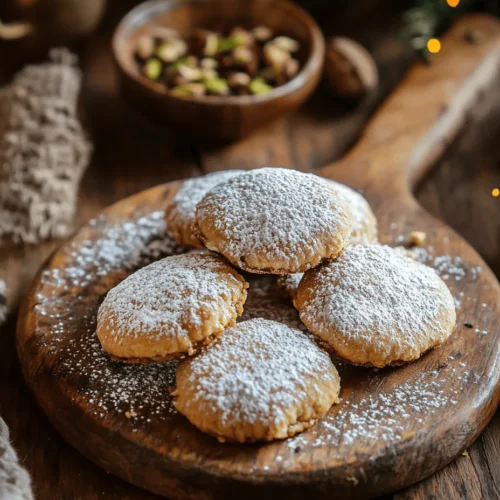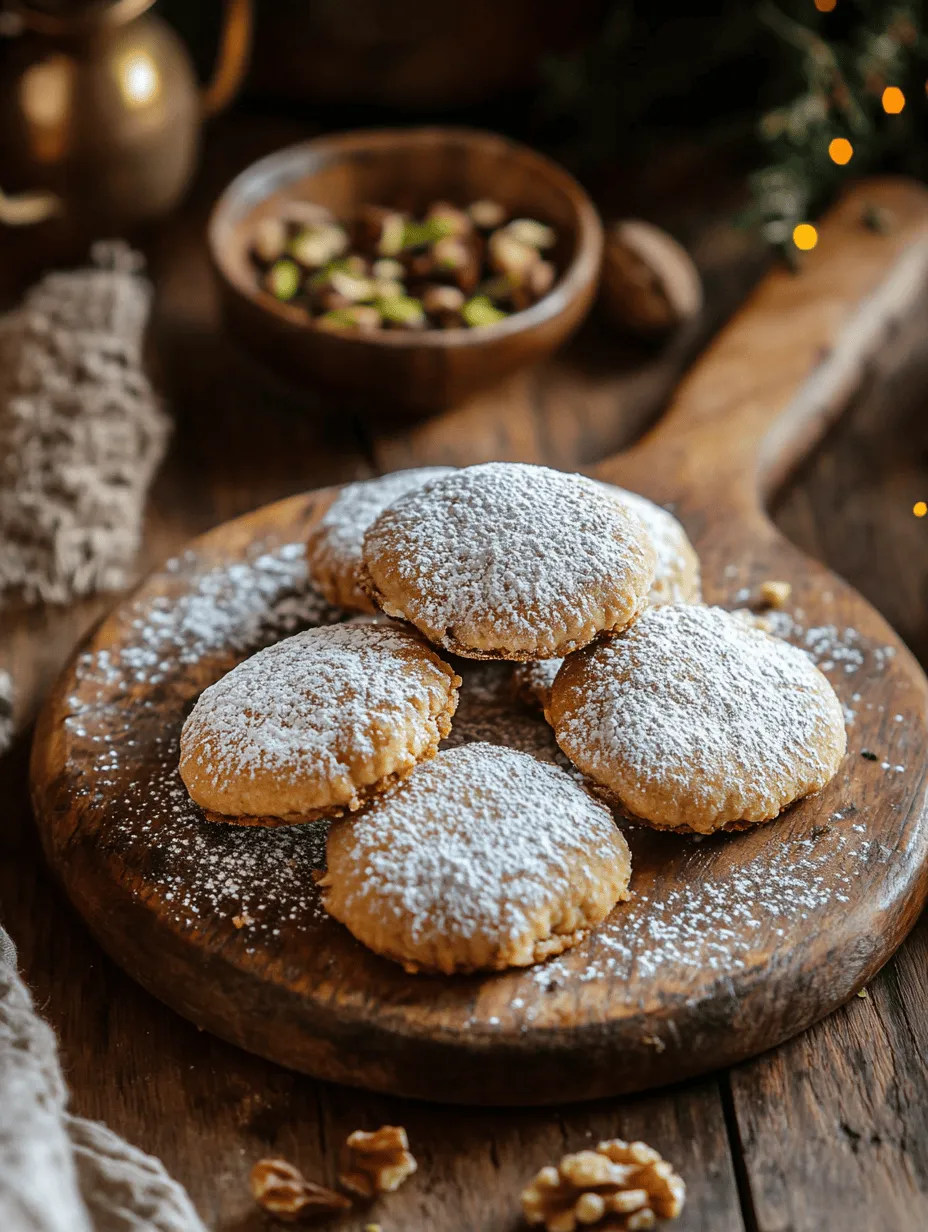Introduction
Kahk El Eid, or simply Kahk, is a beloved traditional cookie that holds a special place in Egyptian culture, particularly during the auspicious celebrations of Eid al-Fitr and Eid al-Adha. These delightful cookies, often dusted with powdered sugar, are more than just a sweet treat; they embody the warmth of familial bonds and the spirit of community. In Egypt, the preparation and sharing of Kahk El Eid is a time-honored ritual that brings families together in the days leading up to Eid, signifying joy, generosity, and togetherness.
The allure of Kahk El Eid lies not only in its rich flavors but also in its unique ingredients, which reflect the culinary heritage of Egypt. Each bite offers a delightful combination of sweetness and a hint of spice, leaving a lasting impression that keeps family members and friends coming back for more. The process of making these cookies is steeped in tradition, often passed down through generations, and each family may have its own twist on the recipe, making it a cherished and personalized experience.
Delving into the world of Kahk El Eid is not just about indulging in a delectable treat; it’s about celebrating culture, sharing history, and creating memories. As we explore this recipe, you will discover the significance of each ingredient and the steps involved in crafting these cookies, ensuring that you can recreate the magic of Kahk El Eid in your own kitchen.
Understanding the Ingredients
To truly appreciate Kahk El Eid, it is essential to understand the role of each ingredient that contributes to its unique flavor and texture. Here’s a breakdown of the key components involved in this traditional recipe:
All-Purpose Flour
All-purpose flour serves as the foundation of Kahk El Eid, providing the necessary structure and texture to the cookies. Its versatility allows for the perfect balance between a tender crumb and a sturdy base that can hold up to the rich fillings often used. The flour’s protein content is crucial; it helps form gluten, which gives the cookies their characteristic chewiness and structure. For the best results, it’s advisable to sift the flour before measuring to ensure a light, airy texture in the final product.
Unsalted Butter
The use of unsalted butter is vital in creating a rich, flavorful dough. Butter not only adds moisture but also contributes to the cookies’ tender texture. It melts during baking, creating layers that yield a soft and crumbly cookie. Unsalted butter allows you to control the overall saltiness of the recipe, which is particularly important when balancing the sweetness of the powdered sugar and the potential saltiness of other ingredients.
Powdered Sugar
Powdered sugar, also known as confectioners’ sugar, is used in both the dough and as a final dusting over the cookies. Its fine texture dissolves easily, ensuring a smooth sweetness that enhances the overall flavor of Kahk El Eid. In the cookie dough, it contributes to a tender crumb, while the generous dusting on top adds an appealing finish and a burst of sweetness with each bite.
Warm Milk and Active Dry Yeast
Warm milk plays a dual role in the preparation of Kahk El Eid. It is used in conjunction with active dry yeast to help the dough rise, leading to a lighter and airier cookie. When combined, the warm milk activates the yeast, causing it to ferment and produce carbon dioxide. This fermentation process is what gives Kahk its distinctive texture. It’s important that the milk is warm but not hot, as excessive heat can kill the yeast, preventing the dough from rising.
Ground Mahleb and Anise Seeds
Ground mahleb and anise seeds are optional ingredients that can elevate the flavor profile of Kahk El Eid, adding a touch of authenticity to the traditional recipe. Mahleb is a spice derived from the seeds of the St. Lucie cherry, imparting a subtle almond-like flavor that pairs beautifully with the sweetness of the cookies. Anise seeds bring a mild licorice flavor, enhancing the overall aromatic experience. While these spices may not be found in every household, their inclusion in the dough is a nod to the traditional methods that have been used for generations.
Mixed Nuts
Mixed nuts are often incorporated into the filling of Kahk El Eid, providing a delightful crunch and a contrast to the soft cookie exterior. Nuts such as walnuts, almonds, or pistachios are commonly used, each bringing its own unique flavor and texture. The use of nuts not only adds richness to the cookies but also symbolizes abundance and prosperity, which aligns perfectly with the celebratory nature of Eid.
The Cultural Significance of Kahk El Eid
The history of Kahk El Eid dates back centuries, with its origins rooted in ancient Egyptian customs. Traditionally, these cookies were prepared in celebration of the end of Ramadan and the arrival of Eid al-Fitr, marking a time of festivity and joy. Over the years, Kahk has become a staple during both Eid celebrations, symbolizing the joy of reunion and the spirit of giving.
During the festive season, families gather to bake Kahk El Eid together, often sharing their unique recipes and techniques. This communal activity not only strengthens family bonds but also fosters a sense of belonging and cultural identity. Each family may have its own variations of the recipe, whether it’s the choice of nuts, the spices used, or the fillings, reflecting the diverse culinary landscape of Egypt.
Kahk El Eid is often served alongside Arabic coffee or tea, enhancing the experience of sharing these cookies with loved ones. The ritual of offering Kahk to guests during Eid embodies hospitality and generosity, reinforcing the cultural significance of sharing food as an expression of love and care.
In comparison to other traditional cookies from around the world, Kahk El Eid stands out for its unique flavors and cultural roots. Similar to Italian biscotti served during festive occasions or German Lebkuchen cookies during Christmas, Kahk has its own distinct identity while sharing the common theme of celebration through food.
Step-by-Step Guide to Making Kahk El Eid
Now that we have explored the cultural significance and ingredients of Kahk El Eid, let’s dive into the step-by-step process of making these traditional cookies. Follow these detailed instructions to recreate the magic of Kahk El Eid in your kitchen:
Step 1: Gather Your Ingredients
Before starting, ensure you have all the necessary ingredients on hand. This includes all-purpose flour, unsalted butter, powdered sugar, warm milk, active dry yeast, ground mahleb, anise seeds (if using), and mixed nuts for the filling. Preparing everything in advance will streamline your baking process.
Step 2: Activate the Yeast
Begin by activating the yeast. In a small bowl, combine the warm milk with the active dry yeast and a teaspoon of sugar. Allow this mixture to sit for about 5-10 minutes until it becomes frothy. This indicates that the yeast is alive and ready to help your dough rise.
Step 3: Prepare the Dough
In a large mixing bowl, combine the all-purpose flour and powdered sugar. Use a whisk to blend them together thoroughly, ensuring there are no lumps. Next, create a well in the center of the dry ingredients and add the softened unsalted butter. Use your fingers to rub the butter into the flour mixture until it resembles coarse crumbs.
Once the butter is well incorporated, pour the activated yeast mixture into the well, followed by any additional flavors such as ground mahleb and anise seeds. Mix everything together until a soft dough begins to form. If the dough feels too sticky, you can add a little more flour, but be cautious not to overdo it.
Step 4: Knead the Dough
Transfer the dough onto a lightly floured surface and knead it for about 5-7 minutes. The kneading process is crucial as it helps develop the gluten, resulting in a better texture for your cookies. Aim for a smooth and elastic dough that is no longer sticky to the touch.
Step 5: Let the Dough Rise
Place the kneaded dough in a lightly greased bowl, covering it with a clean kitchen towel or plastic wrap. Allow it to rise in a warm place for about 1-2 hours, or until it has doubled in size. This step is essential for achieving the light and airy texture characteristic of Kahk El Eid.
Step 6: Prepare the Filling
While the dough is rising, you can prepare the filling. If you’re using mixed nuts, chop them coarsely and set them aside. You can also mix in a bit of sugar and a pinch of cinnamon for added flavor if desired.
Step 7: Shape the Cookies
Once the dough has risen, punch it down to release any air bubbles. Divide the dough into small balls, about the size of a golf ball. Take each ball and flatten it slightly in your palm. Place a teaspoon of the nut mixture in the center and fold the edges over to seal the filling inside, shaping it into a round ball again.
Step 8: Bake the Cookies
Preheat your oven to 350°F (175°C). Arrange the shaped cookies on a baking sheet lined with parchment paper, leaving some space between them. Bake for 15-20 minutes, or until the bottoms are lightly golden. Keep an eye on them to ensure they don’t overbake, as you want them to remain soft and tender.
Step 9: Dust with Powdered Sugar
Once the cookies are baked, remove them from the oven and allow them to cool on a wire rack. While they are still warm, generously dust the tops with powdered sugar. This not only adds sweetness but also creates an inviting appearance.
These steps outline the initial method for creating Kahk El Eid. In the next part of this article, we will explore additional tips for achieving the best results, as well as answer common questions about this delightful Egyptian cookie. Stay tuned for more insights and culinary wisdom as we continue our journey into the world of Kahk El Eid!

Activating the Yeast: Importance of Temperature and Timing
Activating the yeast is a vital step in preparing Kahk El Eid, as it ensures the cookies rise properly and achieve the desired texture. The key to successful yeast activation lies in the temperature of the liquid used and the timing of the process. Warm water or milk, ideally between 100°F to 110°F (37°C to 43°C), is perfect for this task. If the liquid is too hot, it can kill the yeast, leading to flat cookies. Conversely, if it’s too cold, the yeast will not activate effectively.
To activate the yeast, combine it with the warm liquid in a small bowl. Add a pinch of sugar to feed the yeast and stir gently. Allow the mixture to sit for about 5 to 10 minutes until it becomes frothy. This is a clear indicator that the yeast is alive and ready to be incorporated into your dough.
Mixing the Dough: Techniques for Achieving the Right Consistency
Once the yeast is activated, it’s time to mix the dough. In a large mixing bowl, combine the flour, sugar, and any spices, such as ground cinnamon or nutmeg, that you wish to include. Make a well in the center of the dry ingredients and pour in the activated yeast mixture along with melted butter or oil, depending on your preference.
When mixing the dough, use a wooden spoon or your hands to gradually incorporate the flour into the wet ingredients. The goal is to achieve a sticky dough that pulls away from the sides of the bowl but is not overly wet. If the dough seems too dry, add a tablespoon of warm water at a time until the right consistency is reached. Conversely, if it’s too sticky, sprinkle in a bit more flour.
Kneading: Explanation of the Process and Its Effects on the Dough
Kneading is an essential technique that develops the gluten in the dough, resulting in a chewy and well-structured cookie. Once your dough has come together, transfer it onto a lightly floured surface. Knead the dough by pressing it with the heels of your hands, folding it over itself, and turning it a quarter turn. Repeat this process for about 5 to 10 minutes until the dough becomes smooth and elastic.
An important aspect of kneading is to monitor the dough’s texture. If it feels too sticky, sprinkle a little flour as you knead. Conversely, if it feels dry, you can wet your hands slightly to help incorporate moisture. Properly kneaded dough will spring back when gently pressed and should have a soft, pliable texture.
Shaping and Filling the Cookies: Tips for Managing the Dough and Filling Variations
With the dough prepared, it’s time to shape your Kahk El Eid. First, divide the dough into small, equal portions—approximately the size of a golf ball. This will make it easier to manage and ensure uniform cookies.
When it comes to filling, traditional options include a mixture of ground nuts (such as walnuts or pistachios), sugar, and spices. You can also experiment with dates or chocolate for a modern twist. To fill the cookies, use your thumb to create a small indentation in the center of each dough ball. Place about a teaspoon of the filling inside and fold the dough over to encase the filling, pinching the edges to seal.
For a decorative touch, you can shape the filled dough into various forms, such as crescents or rounds, and use a fork or stamp to create patterns on the surface. This not only adds visual appeal but also helps to indicate the cookie’s filling.
Baking: Key Indicators for Knowing When the Cookies Are Perfectly Baked
Baking Kahk El Eid requires careful monitoring to ensure they reach the perfect doneness. Preheat your oven to 350°F (175°C). Line a baking sheet with parchment paper to prevent sticking. Place the shaped cookies on the sheet, leaving some space between them to allow for expansion.
Bake the cookies for about 15 to 20 minutes. Look for a light golden color on the tops and a slightly firm texture. A good indicator that they are done is the pleasant aroma wafting through your kitchen. It’s important not to overbake them, as they can become dry. Allow the cookies to cool slightly on the baking sheet before transferring them to a wire rack.
Cooling and Dusting: Importance of Cooling Time and Presentation Tips
Cooling is often an overlooked step that significantly affects the final texture of your Kahk El Eid. After baking, let the cookies rest on the baking sheet for about 5 minutes before moving them to a wire rack. This allows the steam to escape, preventing sogginess.
Once the cookies are completely cooled, it’s time for the finishing touch—dusting with powdered sugar. This classic presentation not only enhances their appearance but also adds a delightful sweetness. Use a fine sieve to sprinkle the sugar evenly over the cookies, creating a snowy effect that’s reminiscent of festive celebrations.
Common Mistakes to Avoid
When preparing Kahk El Eid, several common mistakes can impact your cookie-making experience. One frequent error is not allowing the yeast to activate properly. Always ensure that your liquid is at the right temperature and give the yeast enough time to froth.
Another common issue is the dough’s consistency. If it’s too sticky, it can be difficult to handle, while dry dough can yield tough cookies. Adjust your flour and liquid amounts gradually until you achieve a smooth, pliable texture.
Overbaking is another pitfall—keep an eye on your cookies, as they can go from perfectly baked to burnt in a matter of minutes. Lastly, when filling the cookies, be careful not to overfill, as this can lead to bursting during baking.
Serving Suggestions
Kahk El Eid is best enjoyed fresh, but it pairs beautifully with various beverages. Traditional options include a steaming cup of Egyptian tea or strong Arabic coffee, both of which enhance the flavors of the cookies.
For gatherings and celebrations, consider presenting the cookies on a decorative platter, perhaps alongside a selection of nuts and dried fruits. This not only creates an appealing display but also invites guests to indulge in a variety of flavors.
These cookies are versatile and can be enjoyed year-round, not just during festive occasions. Their delightful taste makes them a fantastic addition to any dessert table, and they can be packaged beautifully for gifts or special occasions.
Nutritional Information
While Kahk El Eid is a delicious treat, it’s essential to consider the nutritional aspects. Each cookie contains ingredients like flour, sugar, and butter, which contribute to its caloric content. Moderation is key during festive seasons, as indulging in these cookies can quickly add up in terms of calorie intake.
Remember that the cookies can be enjoyed as part of a balanced diet, especially when shared with family and friends. The joy of making and sharing Kahk El Eid often outweighs the nutritional concerns, making them a cherished tradition.
Conclusion
Making Kahk El Eid is more than just a culinary endeavor; it’s a celebration of tradition, family, and cultural heritage. The process of preparing these cookies—activating the yeast, mixing the dough, kneading, shaping, and baking—brings families together, creating memories that last a lifetime.
As you embark on this baking journey, embrace the joy of sharing your creations with loved ones. The act of making these cookies signifies the warmth of Egyptian hospitality and the importance of preserving traditions through cooking. So gather your family, roll up your sleeves, and try making Kahk El Eid this festive season. You’ll not only enjoy delicious cookies but also strengthen your connection to a rich cultural legacy.



